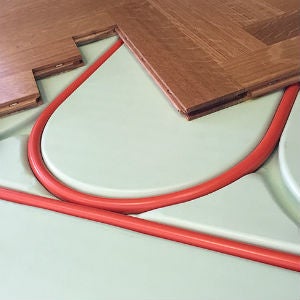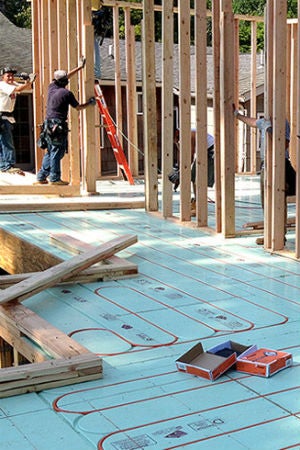Building or Remodeling? The One Question You’re Forgetting to Ask
 Planning to add onto or remodel your home is equal parts exciting and hectic. There are so many decisions to make: countertops, wall colors, floor coverings, fixtures, and more. You can spend hours poring over color swatches, studying carpet samples, and reading appliance reviews. In the end, however, when all these pieces come together, your home will no doubt look incredible, but will you be comfortable in your new home?
Planning to add onto or remodel your home is equal parts exciting and hectic. There are so many decisions to make: countertops, wall colors, floor coverings, fixtures, and more. You can spend hours poring over color swatches, studying carpet samples, and reading appliance reviews. In the end, however, when all these pieces come together, your home will no doubt look incredible, but will you be comfortable in your new home?
Comfort should be a top priority during the design phase of any new construction or remodeling project. In fact, it should come before most aesthetic considerations because it can affect so many other facets of the project, including the order in which the work proceeds, the choice of materials, and even room layout. Still, while many homeowners are busy concentrating on style, they too often allow their contractors to make all the mechanical decisions, including plumbing, HVAC, and wiring—selections that have a lasting impact on a home’s efficiency and comfort level.
Generally speaking, contractors and subcontractors are often inclined to use familiar technology in all their building and remodeling projects. Unless building codes change, prompting them to change, many will continue to install the same mechanical elements for decades. This isn’t necessarily a bad thing; after all, certain tried-and-true plumbing and electrical codes are put in place to protect residents. But when it comes to creating a truly comfortable indoor environment, your contractor might be missing out on an opportunity by sticking to the same old, same old.
Given the amount of effort required, homeowners undertaking a construction project want to get the most possible use out of their new, improved space year-round. To that end, discussions with a contractor should always begin with a simple question: “What is the best way to control the temperature and keep the place comfortable year-round?”
UNDERSTANDING YOUR OPTIONS

Photo: warmboard.com
Traditional forced-air heating systems can certainly warm your home on a cold day, just without much consistency or efficiency. When a forced-air furnace turns on, it blasts hot air into the home, usually through one or two metal registers placed along the edges of each room. The hot air will travel throughout the space, but much will ultimately rise to the ceiling, leaving the lower portion of the room chilly and draft-prone. Forced-air heat also has the undesirable tendency to dry out the air, so family members may suffer from dry skin and increased respiratory issues.
If you’re not familiar with the concept of using radiant floor heat to heat your whole house, you probably also don’t realize how superior this solution is to traditional forced-air heating. Hydronic radiant systems use heated water that runs through a network of tubes just beneath the surface of the floor to transfer warmth into a space. By warming the floor first and allowing that warmth to radiate throughout the room, the system not only uses less energy, but it also heats your entire home more evenly.
With radiant floor heating, residents in the home will be just as comfortable lounging on the carpeting as they are snuggled under a fuzzy throw on the sofa—even on the coldest winter days. As well, installing a radiant-heating system like Warmboard provides consistent warmth throughout the room, eliminating the hot/cool temperature zones traditionally associated with a forced-air heating system. Gentle warmth emanates through flooring, furniture, and throw rugs, and into the air without creating drafts. No more overly dry air that chaps lips, no more icy shock to your feet when you get out of bed in the morning, and no more startling noises when the furnace kicks on.
CHOOSING TOP PERFORMANCE

Photo: warmboard.com
Radiant floor technology has been around in new home construction for more than half a century. In the 1950s, systems with complex copper pipe assemblies embedded in concrete slabs were great in concept, but their installation was time- and labor-intensive. Plus, if the slabs cracked—which concrete has a tendency to do—the copper pipes suffered damage as well. The advent of cross-linked polyethylene (PEX) tubing opened up a new world of possibilities for radiant floor heating, but the improved heated substrates for finished floors still had some drawbacks, chief among them the fact that concrete is very heavy, so structural adjustments were needed in order to bear the floor’s weight.
Radiant concrete-based systems are still being installed today, but they’re not as efficient, nor as builder-friendly, as some of the other options on the market. Just as you would compare ratings and reviews before you purchase a new refrigerator, it’s also wise to compare the benefits and considerations of different radiant floor systems before choosing one.
Industry leader Warmboard, for example, has done away with the concrete slab in favor of grooved subfloor panels, tailor-made for use either in new home construction or over the subfloors of existing homes, that install easily without adding undue weight to the home’s structure. Not only are these panels easier to install, but the design’s inclusion of an integrated aluminum layer helps the system radiate heat more quickly (within minutes!) over a wider area and without cold spots. That extra efficiency translates directly into energy conservation: Warmboard uses water that’s as much as 30 degrees cooler than is required by other hydronic radiant systems, so you’ll save on monthly electricity bills. And because operating costs are lower for Warmboard than for competing systems, you’ll realize a payoff on your initial investment sooner while enjoying the comfort immediately.
Perhaps best of all for a homeowner (or homeowner-to-be) who is deeply interested in aesthetics, Warmboard is suitable for virtually any type of floor covering, so your home’s final design can look exactly as you imagined it.